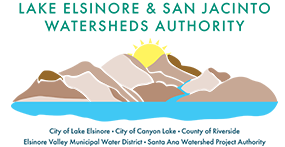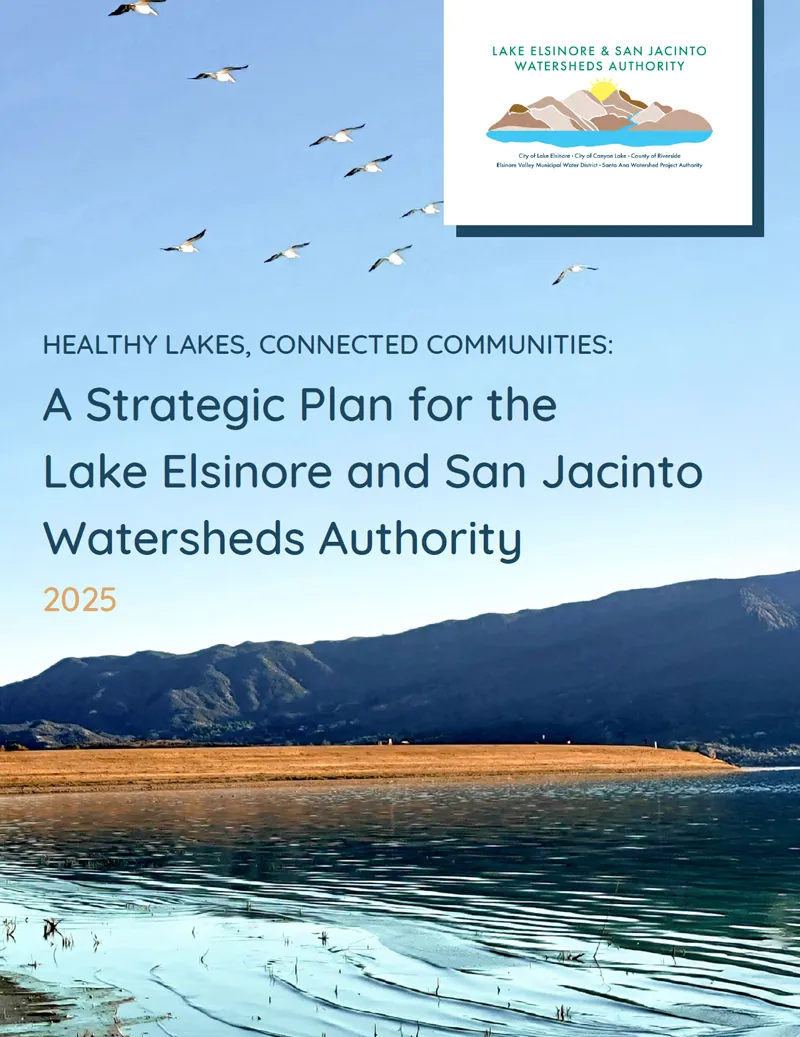LESJWA’s Strategic Plan
Learn about LESJWA’s Strategic Plan
Click on any tab below to expand.
The Lake Elsinore and San Jacinto Watersheds Authority (LESJWA) is a joint powers authority comprised of five member agencies: City of Canyon Lake, City of Lake Elsinore, County of Riverside, Elsinore Valley Municipal Water District, and the Santa Ana Watershed Project Authority. This Strategic Plan continues that legacy by unifying our efforts around a shared vision, mission, and a set of guiding values and goals. It is a commitment that reflects LESJWA’s collaborative spirit and long-standing dedication to protecting Canyon Lake and Lake Elsinore.
This document presents our key strategic elements in a concise, clear format. Our overarching aim is to provide a framework that drives results while honoring the unique character of our watershed. Through collaboration with partner agencies, local communities, and various stakeholders, we strive to ensure that our lakes remain resilient, healthy, and welcoming for current and future generations.
LESJWA’s role in managing these vital water resources has evolved over time, guided by scientific research and shaped by community needs. In developing this Strategic Plan, we revisited our former business plans, gathered feedback from member agencies and stakeholders, and re-examined the physical and social factors impacting Canyon Lake, Lake Elsinore, and the surrounding watershed.
The process built upon decades of experience in addressing water quality challenges, implementing remediation efforts, and balancing competing interests in the watershed. Informed by lessons learned and successes achieved, this plan incorporates the latest data and methodologies to keep our lakes healthy in the face of climate uncertainties, growing populations, and changing economic conditions.
The purpose of this Strategic Plan is to provide a focused blueprint for action—one that outlines key priorities, fosters partnerships, and aligns all participants on a common path. By articulating a unifying vision, a clear mission, and well-defined goals, LESJWA ensures that future initiatives reflect shared values, meet community needs, and deliver measurable progress in environmental stewardship.
LESJWA is the beacon that drives community and ecological success in the San Jacinto River Watershed.
What the Vision Means: A vision paints a long-term picture of our desired future. For LESJWA, it means becoming the guiding force that unites agencies, stakeholders, and communities under the shared goal of achieving a healthy watershed—one that nurtures both the natural environment and local livelihoods. It serves as our north star, inspiring us to continuously innovate and collaborate for the overall success of the region.
Sustain the health of Canyon Lake and Lake Elsinore to enhance water quality, recreational opportunities, and regional economic viability.
Why the Mission Is Important: While the Vision is our aspiration, the Mission is our day-to-day compass. It sets out the core responsibilities we must fulfill—protecting water quality, supporting recreational experiences, and sustaining economic vitality. This ensures that each program, partnership, and project we pursue remains firmly rooted in practical, results-driven work that serves our watershed’s communities and ecosystems.
How Values Guide LESJWA: Values reflect the core principles that govern how LESJWA operates and makes decisions. They anchor everything from planning to on-the-ground actions, ensuring that we remain accountable and that our approach is transparent, equitable, and thoughtful. These values foster trust with our partners, stakeholders, and the public, reinforcing the integrity of our work.
- Stewardship: Prioritize actions and decisions that maintain public health and improve water quality.
- Collaboration: Work together across agencies, regulators, organizations, and communities, maintaining transparent communication to achieve common goals.
- Sustainability: Commit to long-term environmental health and economic prosperity, building the capacity of our lakes and watershed to thrive under changing conditions.
- Financial Prudence: Consistently seek the most advantageous outcomes when funding, supporting, and achieving our goals.
- Sound Decision-Making: Use scientific research and data-driven approaches to guide our decisions.
Why Goals Matter: Our goals translate the Vision, Mission, and Values into actionable priorities. Each goal targets a key area of focus, ranging from clarifying what “healthy lakes” means in measurable terms to securing the resources needed for long-term resiliency. By defining clear objectives, we can more effectively gauge progress, adjust strategies, and build on successes as conditions and challenges evolve.
- Define what constitutes healthy lakes and promote efforts to meet that definition.
- Strengthen collaboration and data sharing between agencies, communities, and the upper watershed.
- Improve the long-term sustainability of the lakes by adapting to the impacts of climate uncertainties and evolving environmental challenges.
- Promote a culture of transparency and accountability.
- Secure and leverage funding for watershed projects, ensuring long-term financial sustainability.
- Investigate promising technologies to advance the stewardship of the lakes.
The following sections include initiatives and strategies LESJWA may pursue in support of each goal. These items reflect a collaborative approach that engages expert panels, local communities, regulatory partners, and other stakeholders.
Define what constitutes healthy lakes and promote efforts to meet that definition.
- Describe What Defines Healthy Lakes
Establish a clear understanding and definition of what constitutes a healthy lake. This sets the foundation for all subsequent efforts. - Define Healthy Lakes from Stakeholder Perspectives
Identify and define the beneficial uses of the lake from various agencies, cities, and stakeholder perspectives. - Develop an Approach to Define Lake Metrics for Healthy Lakes
Independent expert panel to define short-, mid-, and long-term options for achieving healthy lakes. - Develop a Work Plan and Schedule
Create a detailed plan for LESJWA and partners outlining specific actions (including mitigation and treatment options), milestones, and timelines to achieve the defined Healthy Lakes. - Implement Projects and a Monitoring Program
Execute the projects and establish a monitoring program to ensure ongoing assessment and maintenance of the lakes’ health.
Strengthen collaboration and data sharing between agencies, communities, and the upper watershed.
- Streamline Processes and Reduce Inefficiencies
Communicate and coordinate with member agencies on information sharing. - Strengthen Collaboration Among LESJWA Member Agencies
Hold quarterly planning managers’ meetings. - Engage Watershed Stakeholders
Provide regular presentations at stakeholder events.
Engage with Lake Elsinore and Canyon Lake TMDL Task Force stakeholders on a watershed approach. - Educate and Inform the Public
Create and update a public dashboard.
Host and attend local community events with all members.
Improve the long-term sustainability of the lakes by adapting to the impacts of climate uncertainties and evolving environmental challenges.
- Conduct Sustainability Assessment of Lakes
Assess the impacts of climate change and environmental challenges on the lakes and local communities - Participate in SAWPA Climate Adaptation and Resilience Plan Development
Define climate risks, vulnerabilities, and adaptation strategies that support the vision of Healthy Lakes. - Evaluate Historical Trends and Model Future Climate Change Scenarios
Combining historical data with future forecasts provides a comprehensive approach to lake management in support of achieving the vision of Healthy Lakes.
Promote a culture of transparency and accountability.
- Establish Clear Roles and Responsibilities
- LESJWA Board of Directors
- LESJWA Member Agencies
- LESJWA/SAWPA Staff
- LE/CL TMDL Task Force Stakeholders
- Encourage Active Involvement in Decision-making
LESJWA Member Agencies - Promote Integrity and Transparency in Organizational Actions and Decisions
Provides a forum for open communication to facilitate collaborative decision-making
Secure and leverage funding for watershed projects, ensuring long-term financial sustainability
- Develop Budget to Reflect LESJWA Goals
- Develop Cost-Share Agreements as Needed
- Identify Additional Funding Partners, Including Within the Upper Watershed
- Pursue Grant Funding Based on Defined Need and Approach
Investigate promising technologies to advance the stewardship of the lakes.
- Convene an Independent Expert Panel to Develop a Roadmap for Healthy Lakes
- Facilitate Regular Engagement Between Member Agencies and Advanced Technology Experts
- Support Pilot Projects to Rigorously Test Available Technologies
This Strategic Plan represents a balanced and collaborative roadmap designed to protect and enhance Canyon Lake and Lake Elsinore while fostering economic growth and community well-being. Guided by a clear Vision, Mission, Values, and Goals, LESJWA is poised to implement these strategies in coordination with our partners and stakeholders. By investing in sound science, engaging local voices, and prioritizing transparency, we reaffirm our commitment to preserving these vital water resources now and for generations to come.
View LESJWA’s Strategic Plan
Click on the image below to view LESJWA’s Strategic Plan PDF.

